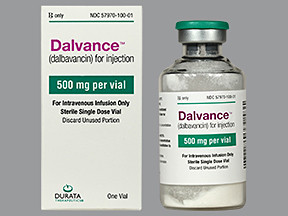DALBAVANCIN - INJECTION
PHONETIC PRONUNCIATION: (DAL-ba-VAN-sin)
COMMON BRAND NAME(S): Dalvance
GENERIC NAME(S): dalbavancin HCl
Uses
USES: This medication is used to treat serious bacterial infections of the skin. It works by stopping the growth of bacteria.
How to use DALBAVANCIN - INJECTION
HOW TO USE: This medication is given by injection into a vein as directed by your doctor, usually as two doses. The first dose will be followed by a second dose one week later. This medication should be injected slowly over 30 minutes. The dosage is based on your medical condition and response to treatment. If you are using this medication at home, learn all preparation and usage instructions from your health care professional and the product package. The solution is normally clear and colorless or yellow. Before using, check this product visually for particles or discoloration. If either is present, do not use the liquid. Learn how to store and discard medical supplies safely. Continue to use this medication until the full prescribed amount is finished, even if symptoms disappear after a few days. Stopping the medication too early may result in a return of the infection. Tell your doctor if your condition persists or worsens.
Side Effects
Precautions
Interactions
Overdose
Images
Reviews
Faq for DALBAVANCIN - INJECTION
Dalbavancin is an injectable antibiotic used to treat various bacterial infections, including skin and soft tissue infections.
Dalbavancin works by interfering with the synthesis of the bacteria's cell wall, leading to the death of the bacteria.
Dalbavancin is commonly used to treat complicated skin and soft tissue infections caused by certain bacteria, including methicillin-resistant Staphylococcus aureus (MRSA).
Dalbavancin is administered as a single injection into a vein (intravenous or IV) over a period of 30 minutes.
Common side effects of Dalbavancin include nausea, headache, diarrhea, and skin rash. It is important to report any severe or persistent side effects to a healthcare professional.
The half-life of Dalbavancin is around 346 hours, which means it stays in the body for an extended period. However, the exact duration may vary depending on factors such as individual metabolism and overall health.
Dalbavancin may interact with certain medications, including anticoagulants (blood thinners) and medications that affect liver enzymes. It is important to inform your healthcare provider about all the medications you are taking to avoid potential interactions.
The safety of Dalbavancin during pregnancy has not been established, and it is generally not recommended unless clearly necessary. It is also not known if Dalbavancin passes into breast milk, so it is advisable to consult a healthcare professional before using it while breastfeeding.
Dalbavancin is known for its long half-life, which allows for a prolonged antibacterial effect. Depending on the severity and type of infection, improvement may be noticed within a few days to a week.
Disclaimer
IMPORTANT: HOW TO USE THIS INFORMATION: This is a summary and does NOT have all possible information about this product. This information does not assure that this product is safe, effective, or appropriate for you. This information is not individual medical advice and does not substitute for the advice of your health care professional. Always ask your health care professional for complete information about this product and your specific health needs.

No Reviews Yet